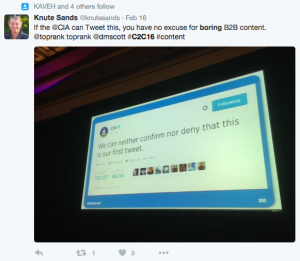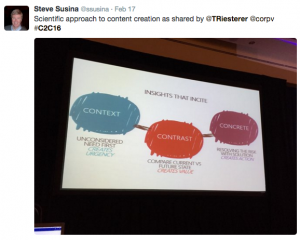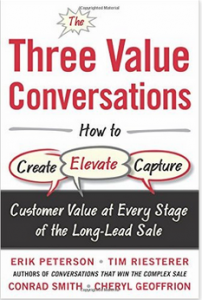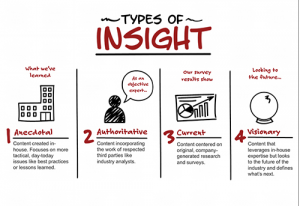Timothy Riesterer's Blog, page 23
February 22, 2016
The Death of Boring: A C2C 2016 Recap
“B2B does not mean ‘Be too boring.’”
Author David Meerman Scott said it in his keynote at Content2Conversion 2016 in Scottsdale. It was one of those remarks that seemed to divide the room, producing ripples of laughter in some corners, squirms of unease in others. But whether you were laughing smugly or wincing in pain, you could probably appreciate his point.
For too long, B2B marketing and sales messages have suffered from a certain insularity, a sameness of look, tone and style evidenced by tired jargon (“scalable,” “world-class,” “innovation!”), stock photography (women smiling with salad, as Meerman Scott hilariously pointed out), overuse of trendy, nostalgic fonts (“lobster” has found its way onto soda bottles), and the reliance on decades-old messaging “best practices” (how long has “voice of the customer” been around?). 
For prospects and customers, the net effect of all this has been boredom, and when it comes to converting excitement into pipeline with your messaging and content, boredom has a cost. That’s why Meerman Scott’s remark had such a palpable impact on the room.
One way to guarantee you’re not boring anyone in your customer conversations? Tell prospects something they don’t know about a problem or missed opportunity they didn’t know they had.
That topic was a focal point of Tim Riesterer’s Wednesday morning keynote, where he discussed the message differentiation you can gain by identifying and introducing your prospects’ “unconsidered needs.” You can then strengthen your differentiation by linking the needs you’ve brought into the conversation to your unexpected capabilities, showing how you—and you alone—are positioned to solve their most pressing business problems. That messaging approach, unlike the traditional “voice of the customer” model, will increase your prospect’s urgency to leave the status quo and expand the need for your offerings.

And get this: The results of a study Corporate Visions conducted with Dr. Zakary Tormala, a professor at the Stanford Graduate School of Business, revealed that a messaging approach based on unconsidered needs was seen as 41 percent more unexpected and unique than more traditional approaches. Check out the research brief here, which includes an example of what an unconsidered needs-based message looks and sounds like.
Typically, unconsidered needs come in three different forms. By addressing them in your messaging, content and skills, you’ll deliver the story you need to defeat your prospect’s status quo and distinguish your solutions.
Under-valued Needs – These are rapidly approaching trends or problems whose impact has been underestimated by your prospects. Your job is to assert the gravity of these potential problems, underscoring how the risks associated with them could put your prospect’s desired business outcomes in jeopardy. You can do this by using provocative insights and research that, together, amplify the size and speed of these problems, transforming them in your prospect’s mind from mere afterthoughts into urgent priorities. You can then connect these new, more serious considerations to your previously unspecified strengths.
Un-Met Needs – Your prospect or customer doesn’t realize they have these needs because they’ve relied on workarounds and stopgap measures to hide the source of their pain. But make no mistake: That pain is real, and it’s your job to show how their current situation is unsustainable because of it. Having done so, you can lead your prospect toward the fact that you have a more viable, long-term solution.
Unknown Needs – These are longer-range issues that come to light when a vendor has a fix for a problem the prospect wasn’t aware he or she had. By identifying these “off-the-radar” problems and bringing them into the life cycle of the buying decision, you can expand the value of your deals.
Meerman Scott was right: B2B messaging doesn’t have to be boring. To make it clear to prospects that you aren’t boring, and that you are different and better, don’t just focus on solving problems your prospects know about, but on finding ones they don’t.
February 12, 2016
CVI Perspectives: Who Doesn’t Love a Good Underdog Story?
By Cheryl Geoffrion, VP of Consulting Services, Corporate Visions
Who doesn’t love a good underdog story? The come-from-behind against all odds, unpredictable and improbable win that brings people to their feet and tears to their eyes. We are moved by these stories; they touch our heart and inspire us to believe anything is possible. So why is it we are so inspired by these underdog stories and yet resist being the underdog ourselves?
 In your professional sales conversations, the last thing you want to feel like is the underdog. Traditional sales and negotiation teachings are all about you finding YOUR power or taking a strong and confident stand to retake power. The belief is that whoever has the power has the advantage in the negotiation. When the other party has more power than you do, your natural reaction to that dynamic is to power up so you can level the playing field. This assumption is intuitive, it’s instinctual, and it’s been proven to be wrong.
In your professional sales conversations, the last thing you want to feel like is the underdog. Traditional sales and negotiation teachings are all about you finding YOUR power or taking a strong and confident stand to retake power. The belief is that whoever has the power has the advantage in the negotiation. When the other party has more power than you do, your natural reaction to that dynamic is to power up so you can level the playing field. This assumption is intuitive, it’s instinctual, and it’s been proven to be wrong.
In Malcolm Gladwell’s book David and Goliath, he challenges our beliefs and explores a different perspective of advantages and disadvantages. He uses the classic underdog story of David and Goliath to show that there are advantages to being in the low power position and that what may look like a disadvantage may be an advantage after all. He delves into the rules of engagement that shape the outcome of these underdog “battles.”
As the story goes, the giant Goliath was expecting to fight a warrior just like himself… someone who would step forward dressed in armor and do battle in hand-to-hand combat. It never occurred to him or anyone else there that the battle would be fought on anything other than those conventional terms. But the little shepherd boy David chooses to use completely different tactics, substituting speed and surprise for brute strength, and wins the battle with a sling and a stone. The accepted belief of the time, of course, was that the power advantage was completely with Goliath and David had no chance of winning.
We’ve seen this scenario play itself out time and again over the years where battles are won and lost between opposing forces of differing strengths. Gladwell highlights a study done by political scientist Ivan Arreguín-Toft who reviewed every war fought in the past 200 years in which one side was at least 10 times as powerful—in terms of armed might and population—as its opponent. The Goliaths, he found, won 71.5 percent of the time. Even more interesting, he went back and re-analyzed his data looking for what happened when the underdogs acknowledged their weakness and chose an unconventional strategy. In those cases, the “David’s” winning percentage went from 28.5 to 63.6 percent. When underdogs choose not to play by Goliath’s rules, they win, “even when everything we think we know about power says they shouldn’t.”
So how does the underdog story play out in complex B2B sales conversations?
According to ES Research, over the last five years there has been a significant shift in the power dynamic between buyer and seller. Polls now show you and your customers are in complete agreement: the buyer has the most power. Customers come to you with a list of what they want and expect you to simply fill the order. They expect you to come to them to do battle on their field, using their weapons of choice, and they are the ones who set the terms of engagement.
Well, given the finding above about the benefits of a counterintuitive, unexpected approaches, it doesn’t seem to make any sense to enter negotiations by playing the game the way you and everyone else is used to playing it and trying to regain the high power position.
The research on “The Benefits of Dominance Complementarity in Negotiations,” a fancy name for the study of power, specifically proves that when you try to match the “power level” of the person on the other side of the negotiations table, you get worse outcomes, not better. What the studies show is that when two high power parties come together, less value is created in the negotiation, therefore there is less value to claim. This can end with either no deal or a worse deal for both parties. Trying to reduce their power doesn’t work any better.
Your customers have become the Goliath in the room! And, you are firmly planted in the low-power position. This study shows that when you maintain the low power / high power dynamic that already exists in the negotiation instead of trying to exert more or equal dominance, your outcomes are better for both the buyer and seller.
What does this mean for your negotiations approach? This is the first of our series to show you how to optimize your negotiations by using your LOW POWER ADVANTAGE the way David did, applying unexpected, counterintuitive skills to capture maximum value.
To learn more about how this approach to negotiations works, check out this solution brief.
Source: L.Z. Tiedens, M.M. Unzueta, and M.J. Young. “An Unconscious Desire for Hierarchy? The Motivated Perception of Dominance Complementarity in Task Partners.” Journal of Personality and Social Psychology 93, no. 3. 2007.
February 8, 2016
Insights That Excite vs. Incite: A C2C Preview
We’ve been thinking a lot about insights lately, and we’re betting you have been too. Frankly, it’s an anxious time for would-be insights providers. That’s because some of the old formulas for insights development and delivery aren’t holding up well with time. Later this month at Content2Conversion, Tim Riesterer, our chief strategy officer, will unveil new research that validates that idea – and demonstrates that not all insights-based approaches are created equal.
 When we’ve talked about insights in the past, you might’ve heard us railing against things like “true but useless” information, repackaged third party data points, interesting numbers with no change narrative around them, or the over-reliance on anecdotal evidence to support bold claims. And you might’ve seen us cast our lot in favor of insights based on original, company-generated research, as well as messaging and content built around counterintuitive perspectives that force prospects to think differently about how they’re doing things today.
When we’ve talked about insights in the past, you might’ve heard us railing against things like “true but useless” information, repackaged third party data points, interesting numbers with no change narrative around them, or the over-reliance on anecdotal evidence to support bold claims. And you might’ve seen us cast our lot in favor of insights based on original, company-generated research, as well as messaging and content built around counterintuitive perspectives that force prospects to think differently about how they’re doing things today.
But all these points about what insights should or shouldn’t be speak to one simple question—a question that should serve as a litmus test when it comes to insights development: What separates insights that excite prospects for a fleeting moment, versus insights that incite them to take meaningful action?
That question was the driving force of a recent experiment Corporate Visions conducted with Dr. Zakary Tormala, a professor at the Stanford Graduate School of Business. The purpose of the study was to gain a better understanding about what type of insights-based story has the biggest influence in terms of inciting buyers to take action.
Specifically, the study tested the messaging effectiveness of two different types of insights-based approaches:
Risk only insights designed to make prospects feel their status quo is “unsafe” by introducing them to surprising new industry data, statistics or studies.
Risk + Resolution insights that similarly make the status quo feel unsafe, but that also introduce solutions that resolve the prospect to a “new safe” in the same message.
The study found that by delivering an insights-based message that includes both risk and resolution, you stand to gain a statistically significant advantage in two of the most important areas for buyer persuasion. To learn where—and by how much!—your messaging and content can gain an advantage with this approach, join Tim Riesterer for his mainstage session at Content2Conversion on Wednesday, Feb. 17 at 8:40 a.m.
January 7, 2016
You Got the Skills. Do You Have the Story?
When companies dedicate serious budget to skills training, sales leaders seriously expect to see high adoption, behavior changes and revenue impact.
In other words, they’re banking on their new skills making the most profound selling impact possible. But how do you actually ensure that happens? What’s the secret?
As it turns out, getting the most out of your skills training may depend on having a differentiated, content-driven story behind it.
In other words, real, customer-facing messaging and content assets that are aligned to the skills your reps are being trained on, so they can actually have a real-world conversation the day after they leave the room.
 An analysis by Beyond ROI, a company that measures the effectiveness of skills training, found that training is enhanced in terms of adoption and impact when you embed an actual selling story into your skills training program, as opposed to relying on hypothetical situations constructed in the workshop, or using generic or even tailored case studies.
An analysis by Beyond ROI, a company that measures the effectiveness of skills training, found that training is enhanced in terms of adoption and impact when you embed an actual selling story into your skills training program, as opposed to relying on hypothetical situations constructed in the workshop, or using generic or even tailored case studies.
Just what kind of impact can an actual, concrete message have on skills delivery?
Beyond ROI, examining companies who combined Corporate Visions’ skills training and story development, found that such companies reported:
75 percent larger progressed opportunities, compared to companies who just experienced skills training.
A 5-10 percent increase in adoption levels of the new skills just by adding story content to the training, compared to companies who only completed skills training.
So, not only does this combination produce greater impact on business results, it also ensures more salespeople are using the skills they were trained on. And, by training reps on messaging in addition to skills, you ensure that your customers hear a consistent story across the field, and from lead to pipeline to close.
Consistency. Adoption. Results. For marketers and sales leaders, what could be more powerful than that?
December 22, 2015
Selling Value: A Teachable, Learnable Skill
You know sellers have to bring more than product expertise and good rapport to the conversation if you want to articulate why you’re different and better, or in other words, sell value.
 To many, “selling value” is an abstract, complicated concept. But, in this edition of the Sales Evangelist podcast, Corporate Visions’ Tim Riesterer makes it simple and concrete by sharing concepts from his latest co-authored book, “The Three Value Conversations.”
To many, “selling value” is an abstract, complicated concept. But, in this edition of the Sales Evangelist podcast, Corporate Visions’ Tim Riesterer makes it simple and concrete by sharing concepts from his latest co-authored book, “The Three Value Conversations.”
Listen as Tim explains the three “value moments of truth,” and the key skills needed to win in each:
Defeating the status quo and creating the buying vision
Building an executive-level business case
Executing value-based exchanges during negotiations to win larger, more profitable deals.
Enjoy the podcast!
December 21, 2015
Corporate Visions Survey Reveals Top Challenges in B2B Sales Negotiations: Inability to Articulate Value and Lack of Faith in Solution Value
Survey Also Finds Almost Half of Companies Do Not Have a Formal Negotiation Skills Training Program to Give Sales Reps the Content and Skills Needed to Close More Profitable Deals
PLEASANTON, Calif., Dec. 21, 2015 /PRNewswire/ — Corporate Visions, Inc., the leading marketing and sales messaging, content and skills training company, today announced results from a new survey polling more than 300 B2B marketers and salespeople about price negotiations. The data revealed the number one factor impacting margins is the inability of salespeople to articulate value. The second biggest problem respondents ranked was salespeople negotiating against themselves by not believing in their company’s price. Interestingly, despite these struggles and increasing pricing pressures, nearly half (45 percent) of companies polled admitted to not having a formal negotiation skills program to address this critical problem area.
“The newsflash here is that margin erosion isn’t just coming from customers putting pressure on price concessions,” said Tim Riesterer, chief strategy and marketing officer for Corporate Visions. “The survey indicates the primary problem is actually salespeople’s inability to create a perception of value and a lack of confidence to claim that value. It’s clear there’s also still a need for companies to provide formal negotiation skills training that’s not focused on the buyer’s tactics but rather, on the salesperson’s skills at capturing value.”
Additional noteworthy results from the survey include:
Of those companies that do formal negotiations training, 48 percent of respondents said their company focuses on late-stage dealings to avoid excessive discounting and save profit margins during the purchasing and pricing step near the end of the buying cycle. The other 52 percent said they are focused on identifying and plugging potential value or margin leaks that take place throughout the entire complex, multi-buyer sales cycle.
After the top two challenges: inability to articulate value (28 percent) and negotiating against themselves (21 percent) of respondents ranked the following additional negotiations problem areas:
Twenty percent of respondents believe giving away things of value without asking for anything of value in return is the biggest sales negotiation problem.
Fourteen percent said their reps are too quickly discounting to their lowest level of authority without regard for the psychology of concessions or a consistent company policy.
Nine percent believed the problem is waiting for the client to share budget and price instead of anchoring clients with a higher number.
“In today’s negotiations, buyers are in the high-power position because they have all the alternatives. Salespeople are in a low-power position because their alternatives are no deal or no margin, and those aren’t good alternatives,” said Riesterer. “As a result, companies need to make sure they help salespeople take more creative, counter-intuitive approaches to negotiations where they can actually use the low-power position to their advantage, as opposed to many skills training courses that recommend ways to regain power or retake control. Research shows efforts to raise power equality actually produce worse outcomes.”
December 10, 2015
The Biggest Factor to Closing Deals?
Your customer conversations are defined by three “moments of truth”—three distinct but adjacent sales dialogues that reps need to master to win more profitable deals.
Is your team equipped to master them?
A Corporate Visions survey found that 85 percent of companies believe their team’s ability to articulate value messages is the single most critical factor to closing deals.
In this podcast, Corporate Visions’ Tim Riesterer details the three value conversations where your reps need to excel, demonstrating an ability to:
Create Value by defeating the status quo and differentiating your solution.
Elevate Value by building a business case that passes muster with executive buyers.
Capture Value by protecting your pricing and expanding deal size.
Tim’s podcast, based on insights from his new book, “The Three Value Conversations,” appears in two segments below:
To hear about defeating the status quo and differentiating your solution, check out part one: http://www.saleseffectiveness.com/sei-blog/entry/podcast-interview-with-tim-riesterer
To learn how to make a business case to executive buyers, check out part two: http://www.saleseffectiveness.com/sei-blog/entry/podcast-interview-with-tim-riesterer-part-2
Looking to dig deeper into these pivotal sales conversations? Purchase “The Three Value Conversations” here.
December 9, 2015
Corporate Visions Names Jennifer Aaker and Juan Corsillo to Board of Directors
Social Psychologist, Author and Stanford University Graduate School of Business Professor Teams Up With Sales and Marketing Industry Veteran to Help Company Exceed Rapid Growth Goals
PLEASANTON, Calif. – December 9, 2015 – Corporate Visions, Inc., the leading marketing and sales messaging, content and skills training company, today announced the appointment of industry pioneers Jennifer Aaker, Ph.D. and Juan Corsillo to its board of directors. With more than 25 years of experience in their respective fields, both Aaker and Corsillo will help Corporate Visions exceed its next level of growth success in 2016 and beyond.
Currently the General Atlantic Professor of Marketing at Stanford University’s Graduate School of Business, Aaker is the co-author of the award-winning book “The Dragonfly Effect: Quick, Effective and Powerful Ways to Use Social Media to Drive Social Change,” and has served on the advisory board of early-stage startups and companies from ADAY to Google X. With an extensive track record of driving growth and business sustainability for leading multi-billion dollar publicly traded companies in the financial and business services sectors, Corsillo recently retired from his role as SVP of marketing and sales at United Rentals, Inc.
“The board is proud to welcome Jennifer and Juan, whose collective knowledge in social psychology and B2B marketing and sales will be invaluable to our company’s overall strategy in the coming years,” said Paul Murphy, chairman of the board for Corporate Visions and partner at Sentinel Capital Partners. “There is no doubt they will help solidify our overall position as the market leader in providing the content, training and skills – all backed by irrefutable decision-making science – to help customers have more effective sales conversations.”
Acquired by Sentinel Capital Partners in May 2015, Corporate Visions strategically selected these new board appointments to further expand its global presence within the B2B sales and marketing space. Since 2010, Corporate Visions has grown at a compounded annual growth rate of 43 percent per year through both organic growth and four strategic acquisitions. The news also comes on the heels of last month’s appointment of three key additions to the executive team – Gloria Fan as CFO, Leo Hanna as EVP of international sales and Jennifer Zick as EVP of marketing.
“The appointment of both Jennifer and Juan further signifies the commitment we have as a company to the industry, our customers and our prospective clientele,” said Corporate Visions CEO Joe Terry. “We have very ambitious growth goals for 2016, and Jennifer and Juan’s expertise address critical areas that matter most to our business and will help propel us to the next level of expansion to serve our present and future world-class customers.”
As a social psychologist, Aaker’s research focuses on the psychology and rationale behind how people make use of time, money and happiness, and when and why those choices are associated with lasting value. She also empirically explores how small acts can create significant change and how those effects can be fueled by digital and social media. Noted for her early work on the dimensions of brand personality, Aaker’s current research is rooted in the psychology of choice and the shifting meaning of happiness. She also teaches courses at the Hasso Plattner Institute of Design (d.school). She is the recipient of the Distinguished Scientific Achievement Award from the Society for Consumer Psychology and the Stanford Distinguished Teaching Award. Aaker earned a Ph.D. in marketing and psychology from Stanford University and a Bachelor of Art degree in psychology from the University of California, Berkeley.
Corsillo is a seasoned sales executive with a proven track record of building world-class, high-performing and integrated sales and marketing organizations that drive industry-leading growth. Most recently in his role at United Rentals, Inc. – a position he held from 2010 to 2015 – he oversaw all sales-related activities at both the field and national levels, including pricing, sales operations, marketing and managed services offerings. Previously, Corsillo spent 17 years with the General Electric Company (GE Capital) in various capacities, where he held several senior commercial leadership roles, including chief commercial officer for GE Capital Solutions, CMO of U.S. equipment financing and SVP of sales operations of GE Capital Americas. Corsillo earned a Bachelor’s degree in finance with a minor in entrepreneurship from Concordia University in Montreal, Canada.
November 23, 2015
Sales Transformation That Sticks
If you train salespeople, you know all about the ambivalent feeling that sets in after an event.
In one sense, you’re fired up—your reps are energized, confident and excited to apply the great skills and concepts they’ve learned out in the field.
On the other hand, your optimism is tempered by a very legitimate fear: Namely, that in just a few weeks time, the skills your team just learned may already be eroding.
According to Corporate Visions research, only 23 percent of managers provide a significant level of coaching to the skills after their sales force has been trained. That’s why you need to be prepared to provide “virtual coaching” to reinforce skills when your sales managers are strapped.
Corporate Visions’ Tim Riesterer and MobilePaks’ Chanin Ballance recently blogged about how great virtual skills reinforcement drives high adoption, keeps reps sharp on key skills and concepts, and ensures they don’t have to leave the selling workflow to get the learning content they need.
The two picked up on that topic again in a recent webcast, “Sales Transformation That Sticks.” If you’re serious about creating last behavior changes in the field for your team, so they can articulate value in the way they were trained, you need to give this a listen:
November 17, 2015
Insights-based Selling: Everybody’s Doing It…Or Are They?
The traditional approach to insights is becoming commoditized. Here’s how to break from the cycle of “true but useless” information.
Insights are everywhere—at least, that’s the impression in the market. According to a recent Corporate Visions survey, 81 percent of companies say they use an insights-based approach to selling.
But are they actually?
Selling with insights has won such an enthusiastic following so fast that its sheer popularity has outstripped the market’s ability to define it. This has led to various standards—some rigorous, others lax—about what it takes to qualify as an insights provider today.
But, regardless of how companies internally define what insights-based selling is, and regardless of the quality of insights they’re actually delivering, you can bet on this: The approach has been roundly embraced as a key element of provocative selling. In other words, insights, rigorously developed or not, are saturating the market.
What are you doing to make sure yours get noticed?
We’ve talked here and here about four different types of insights—and how not all of them are created equal. Some are simply better than others at revealing deficiencies or missed opportunities in a prospect’s current situation. Some are better than others at opening customers up to persuasion and activating buying intent.
In our survey, respondents deemed “anecdotal” insights (think in-house, tactical, best practices-focused content) to be the least effective in terms of achieving positive selling outcomes. Ironically, respondents said this insight type appeared most often in their campaigns and sales-facing content.
On the other hand, the survey revealed that so-called “visionary” insights, based on original, company-generated research and forward-looking market interpretations, were viewed as the most effective insight type, but were used the least of the four categories.
To be truly visionary, your insights-based message and content must be:
Original – Carry out primary research or market surveys to uncover market-related data. Ensure that they’re statistically relevant and sound.
Exclusive – Generate data points that are unique to you and that you can use as the foundation for developing counterintuitive insights about emerging trends in your market. You can then use insights, which you own, to carve out distinct positioning for your products.
Forward-looking – Develop a content-driven narrative on both sides of the lead handoff that asserts a distinct point of view—a perspective that shapes the conversation and leverages your findings to deliver unique interpretations of emerging issues, challenges and trends.
With insights so pervasive, the bar for qualifying as a credible insights provider is rising, and the traditional “insights” selling model of recycling third party analyst figures, re-packaging the findings and laying claim to the concepts is only going to commoditize your message—because your competitors all have access to the same information as you.
That approach doesn’t deliver insights. It delivers true but ultimately useless information. Well-thumbed analyst reports and established information won’t have the impact on more discerning prospects and customers, who are going to start demanding more rigor behind insights generation. As a result of this shift, companies are going to need to take more edgy, counterintuitive stands, supported by original, research-based rigor—otherwise, you may only be posing as an insights provider.
Timothy Riesterer's Blog
- Timothy Riesterer's profile
- 3 followers





